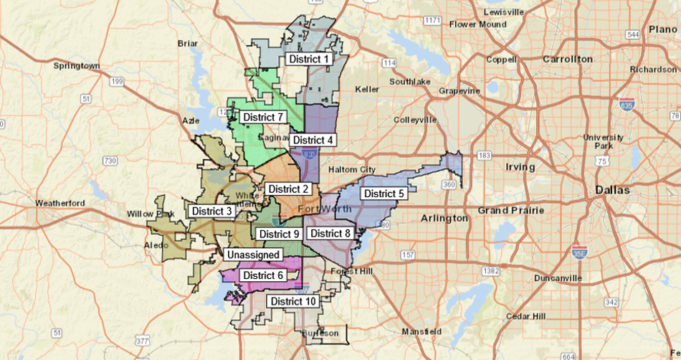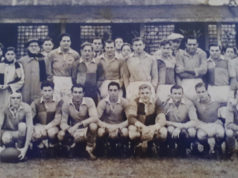Drafting new city districts for voting is akin to a high-stakes game of Whac-A-Mole. Moving the boundary lines in one district could leave a neighboring district running afoul of state or federal voting laws. Past U.S. Supreme Court rulings, for example, dictate that district populations cannot deviate by more than 10%, meaning that the most populated district cannot be more than 10% larger than the smallest district.
In February, Fort Worth City Council will approve a new 10-district map that will allow for 11 voting members (including the mayor) on city council. Five years ago, Fort Worth voters approved a city charter amendment that required city council to redraw its district map following the completion of the 2020 Census. As Fort Worth’s population edges closer to 1 million residents, the increase in councilmembers would hypothetically allow for more representational leadership.
The process has proven to be complicated for several reasons, and, last week, Fort Worth’s councilmembers voted to reactivate the council-appointed redistricting task force to help ensure that benchmarks on the redistricting timeline are met by February. Assistant City Manager Fernando Costa told me in a phone interview that city staff have gone to great lengths to ensure that the redistricting process is transparent and inclusive. Indeed, volunteer task force members and city staffers have held well over a dozen training sessions to teach Fort Worthians about the redistricting process and even how to draw redistricted maps that can be submitted for consideration by the task force and city council.
Critics of the process note that the city’s approach is out of line with recommendations by the Race and Culture Task Force, which was formed in 2017 in response to public uproar following the heavy-handed 2016 arrest of Jacqueline Craig, a Black mother, by a white Fort Worth police officer. One of the Race and Culture Task Force’s 22 final recommendations accepted by city council in late 2018 was the formation of an independent redistricting commission (IRC). Supporters of IRCs note that the independent approach to redistricting removes meddling from self-interested councilmembers who may be more interested in being reelected than protecting the voting rights of citizens.
Fort Worth’s city council is able to skirt that commitment because the city’s elected leaders only “accepted” the recommendations, a legal term that is nonbinding. Fort Worth’s city charter would also have to be amended to allow for an IRC-redrawn map — something that Costa said could not happen in time for the current redistricting process.
Bruce Miller with Citizens for Independent Redistricting said last week’s Fort Worth City Council Redistricting Work Session — something Miller called “Gerrymandering 101” —is an example of why councilmembers should not be involved in redrawing their own maps. Several councilmembers, Miller said, referred to the proposed districts in the possessive sense, as in “my district.”
Costa said the aim of that meeting was to allow city councilmembers to introduce their maps and to consolidate the best maps into one final proposal that will be considered alongside submissions from citizens and civic groups like Citizens for Independent Redistricting. Data from Citizens for Independent Redistricting show that Councilmember Cary Moon’s map has a population deviation of nearly 20% — far outside the allowable 10% maximum.
Moon disagrees with the Citizens for Independent Redistricting numbers. In an email, he said that his office submitted two maps for consideration by councilmembers and the independent task force.
“Both maps were reviewed by legal and are in full compliance with high and low priorities established,” he said. “The next steps for this public process include an independent review of council maps submitted. In that process, maintaining the interest of neighborhoods, transparency, and public engagement are important matters as we move forward to draw 10 new city council districts.”
Councilmember Chris Nettles submitted a map that fell below the 10% threshold. Nettles said in an email that he temporarily withdrew the map and plans to submit two new maps soon. By the end of last week’s meeting, the city councilmembers and mayor were unable to find a map that met all the criteria set by state and federal law as well as the stated goals of the redistricting task force.
“They got it down to two alternative maps,” Costa said. “Neither of which met all of the criteria, particularly the first criterion about districts having approximately equal populations. They still need to do adjustments. When they increased one district, they would bump another district or two out of the range. When they tried to fix those districts, they would bump another district. Trying to balance many competing interests is difficult even under the ideal circumstances. You are trying to keep certain neighborhoods intact. In some cases, some neighborhoods alliances want to be kept together.”
Miller said that his group was disappointed when Fort Worth City Council decided to not move forward with a compromise hybrid approach to redistricting that was recently proposed by Costa. Although the city charter requires councilmembers to vote on the final recommendations, Costa’s proposal would have created an IRC that acted in an advisory capacity.
“The council wasn’t really excited about that idea,” Costa said.
Costa said that allowing the redistricting task force to take the lead on the process minimizes the influence city council has over the process. Councilmembers are not allowed to discuss redistricting outside of public meetings that are advertised 10 days in advance, he said.
From now through December, the redistricting task force will be reviewing maps produced by residents and civic groups. The task force will hold a public meeting in December that will decide which map will be presented to city council’s first work session in January. The map will be subject to four public hearings in February, Costa said, with a final map being approved by city council in late February.
Miller said his group plans to submit one and possibly several maps for consideration by the task force. Even at this late juncture, Miller sees an IRC as the best model for providing a city council district map that would have a low risk of inviting a lawsuit.
An IRC provides a “means of improving trust in government and citizen involvement,” Miller said. That would be an “important symbolic step in improving race relations in Fort Worth. It would also let the citizens choose their districts rather than [letting] the council choose who can vote for them.”












